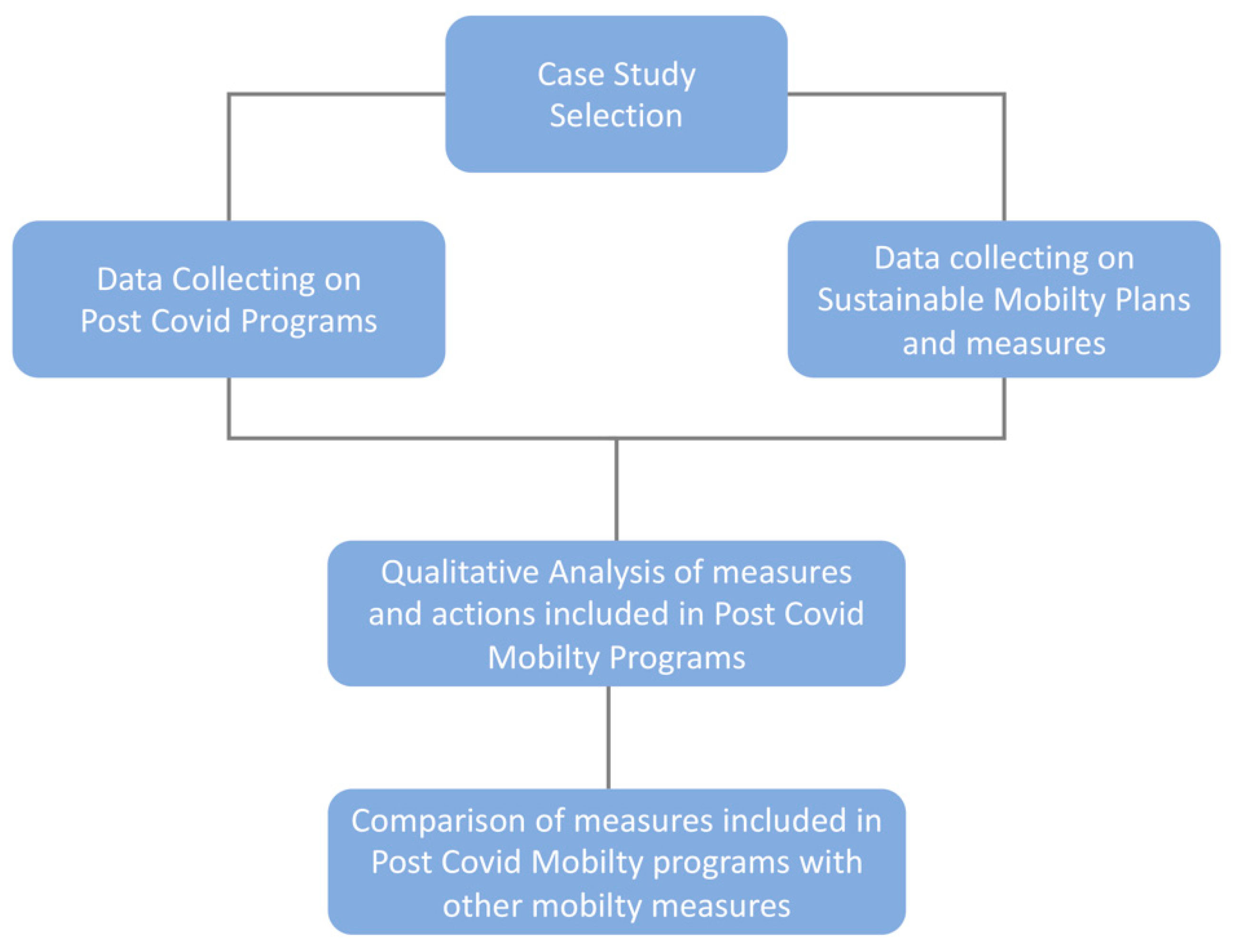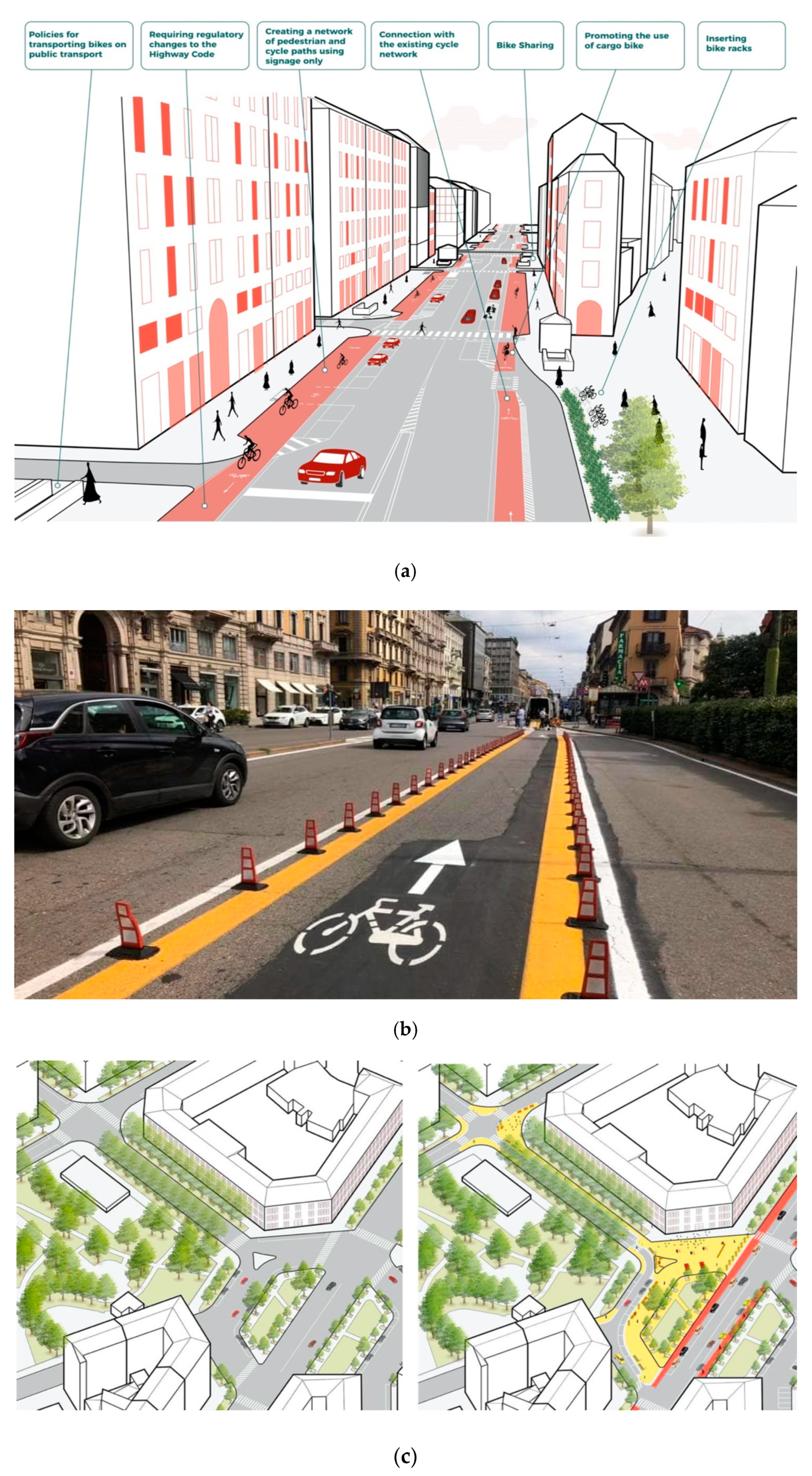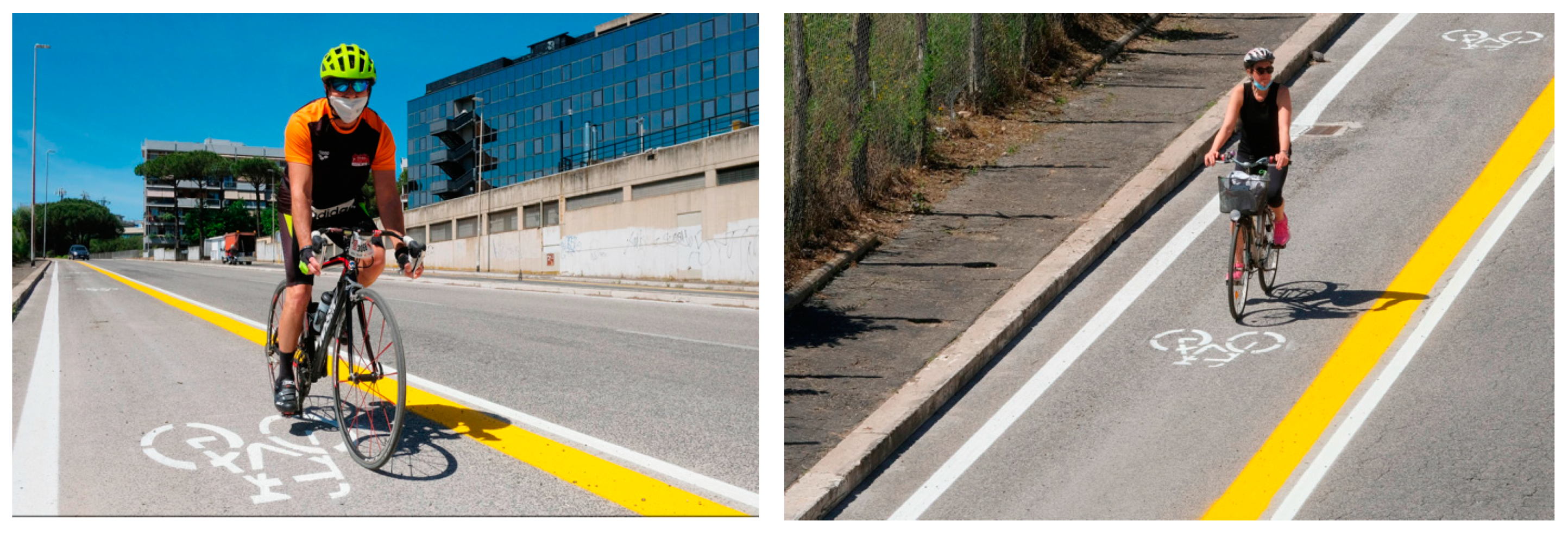The Post Pandemic City: Challenges and Opportunities for a Non-Motorized Urban Environment. An Overview of Italian Cases
Abstract
:1. Introduction
2. Breaking Car Dependence to Recover from the Crisis
- (1)
- Removing motor traffic from residential streets and extending pavements near shops, schools and parks to make walking safe and enjoyable for transit and exercise;
- (2)
- Establishing safe cycling routes to and from schools, offices, and close to main roads, by closing down roads and carriageways where necessary, so that people can have a safer alternative to private cars and public transport;
- (3)
- Creating safe access routes on foot and bike as well as safe public spaces and green areas at the neighbourhood scale, closing roads and squares to motorized traffic.
3. Materials and Methods
3.1. The Italian Case
3.2. The Method
Post Pandemic Mobility Programs
4. Results and Discussions
5. Conclusions
Funding
Conflicts of Interest
References
- World Health Organization. Covid 19 Strategy Update Geneva, April 2020. Available online: https://www.who.int/emergencies/diseases/novel-coronavirus-2019 (accessed on 30 May 2020).
- Wordometer Covid 19 Coronavirus Pandemic. Available online: https://www.worldometers.info/coronavirus/ (accessed on 29 June 2020).
- Hakovirta, M.; Denuwara, N. How COVID-19 Redefines the Concept of Sustainability. Sustainability 2020, 12, 3727. [Google Scholar] [CrossRef]
- Nicola, M.; Alsafi, Z.; Sohrabi, C.; Kerwan, A.; Al-Jabir, A.; Iosifidis, C.; Agha, M.; Agha, R. The socio-economic implications of the coronavirus pandemic (COVID-19): A review. Int. J. Surg. 2020, 78, 185–193. [Google Scholar] [CrossRef] [PubMed]
- Liu, L. Emerging study on the transmission of the Novel Coronavirus (COVID-19) from urban perspective: Evidence from China. Cities 2020, 103, 102759. [Google Scholar] [CrossRef] [PubMed]
- Null, S.; Smith, H. COVID-19 Could Affect Cities for Years. Here Are 4 Ways They’re Coping Now. World Resource Institute. Available online: https://www.wri.org/blog/2020/03/covid-19-could-affect-cities-years-here-are-4-ways-theyre-coping-now (accessed on 25 May 2020).
- Pluchino, A.; Biondo, E.; Giuffrida, N.; Inturri, G.; Latora, V.; Le Moli, R.; Rapisarda, A.; Russo, G.; Zappala, C. A Novel Methodology for Epidemic Risk Assessment: The case of COVID-19 outbreak in Italy. Phys. Soc. 2020, arXiv:2004.02739v3. [Google Scholar]
- Wu, X.; Nethery, R.C.; Sabath, M.B.; Braun, D.; Dominici, F. Exposure to air pollution and COVID-19 mortality in the United States: A nationwide cross-sectional study. MedRxiv 2020. [Google Scholar] [CrossRef] [Green Version]
- Travaglio, M.; Yu, Y.; Popovic, R.; Selley, L.; Santos Leal, N.; Martins, L.M. Links between air pollution and COVID-19 in England. MedRxiv 2020. [Google Scholar] [CrossRef] [Green Version]
- Fattorini, D.; Regoli, F. Role of the chronic air pollution levels in the Covid-19 outbreak risk in Italy. Environ. Pollut. 2020, 264, 114732. [Google Scholar] [CrossRef] [PubMed]
- Johns Hopkins University. Corona Virus Research Centre. Available online: https://coronavirus.jhu.edu/map.html (accessed on 30 May 2020).
- Klaus, I. The Post-Pandemic Urban Future is Already Here. CityLab. Available online: https://www.bloomberg.com/news/articles/2020-04-06/how-will-the-pandemic-transform-urban-space (accessed on 25 April 2020).
- Lefebvr, E.H. Il Diritto alla Città; Ombre Corte: Verona, Italy, 2014; pp. 101–103. [Google Scholar]
- Secchi, B. La Città dei Ricchi e la Città dei Poveri; Laterza: Bari, Italy, 2013; pp. 3–9. [Google Scholar]
- Taylor, M. World Cannot Return to ‘Business as Usual’ after Covid-19, Say Mayors. The Guardian 7 May 2020. Available online: https://www.theguardian.com/environment/2020/may/07/world-cannot-return-to-business-as-usual-after-covid-19-say-mayors (accessed on 30 May 2020).
- Balducci, A. Learning from the COVID-19 Emergency to Transform Cities. Cities Today. Available online: https://cities-today.com/industry/learning-from-the-covid-19-emergency-to-transform-cities/?utm_source=cities-today&utm_medium=newsletter&utm_campaign=200626 (accessed on 30 June 2020).
- Davies, A. The Pandemic Could Be an Opportunity to Remake Cities, Wired, 14 April 2020. Available online: https://www.wired.com/story/pandemic-opportunity-remake-cities/ (accessed on 2 June 2020).
- The Epidemic Provides a Chance to do Good by the Climate. The Economist, 26 March 2020. Available online: https://www.economist.com/science-and-technology/2020/03/26/the-epidemic-provides-a-chance-to-do-good-by-the-climate (accessed on 2 June 2020).
- Acuto, M. Covid-19. Lesson for an Urban(izing) World Cellpress. 2020. Available online: https://doi.org/10.1016/j.oneear.2020.04.004 (accessed on 2 June 2020).
- Megahed, N.A.; Ghoneim, E.M. Antivirus-built environment: Lessons learned from Covid-19 pandemic. Sustain. Cities Soc. 2020, 61, 102350. [Google Scholar] [CrossRef] [PubMed]
- Honey-Rosés, J.; Anguelovski, I.; Chireh, V.K.; Daher, C.; Bosch, C.K.V.D.; Litt, J.S.; Mawani, V.; McCall, M.K.; Orellana, A.; Oscilowicz, E.; et al. The impact of COVID-19 on public space: An early review of the emerging questions—Design, perceptions and inequities. Cities Health 2020, 1–17. [Google Scholar] [CrossRef]
- Harvey, F. Covid-19 Pandemic is ‘Fire Drill’ for Effects of Climate Crisis, Says UN official. The Guardian 15 June 2020. Available online: https://www.theguardian.com/environment/2020/jun/15/covid-19-pandemic-is-fire-drill-for-effects-of-climate-crisis-says-un-official (accessed on 25 June 2020).
- C40 Cities No Return to Business as Usual: Mayors Pledge on COVID-19 Economic Recovery C40 Cities 2020. Available online: https://www.c40.org/press_releases/taskforce-principles (accessed on 12 May 2020).
- The Guardian View on Covid-19 and Climate: Leadership Required. The Guardian 25 June 2020. Available online: https://www.theguardian.com/commentisfree/2020/jun/25/the-guardian-view-on-covid-19-and-climate-leadership-required (accessed on 30 June 2020).
- UN Habitat World Health Organization. Integrating Health in Urban and Territorial Planning: A SOURCEBOOK. UN Habitat—WHO. 2020. Available online: https://www.who.int/publications-detail/integrating-health-in-urban-and-territorial-planning (accessed on 12 May 2020).
- Chatterthon, P. Coronavirus: We’re in a Real-Time Laboratory of a More Sustainable Urban Future. The Conversation 27 April 2020. Available online: https://theconversation.com/coronavirus-were-in-a-real-time-laboratory-of-a-more-sustainable-urban-future-135712 (accessed on 10 May 2020).
- WHO & UNDP. Non-Communicable Diseases: What Municipal Authorities, Local Governments and Ministries Responsible for Urban Planning Need to Know. World Health Organization and United Nations Development Program. 2016. Available online: https://apps.who.int/iris/handle/10665/250228 (accessed on 10 May 2020).
- Bucsky, P. Modal share changes due to COVID-19: The case of Budapest. Transp. Res. Interdiscip. Perspect. 2020, 100141. [Google Scholar] [CrossRef]
- Batty, M. The Coronavirus crisis: What will the post-pandemic city look like? Environ. Plan. B Urban Anal. City Sci. 2020, 47, 547–552. [Google Scholar] [CrossRef]
- Von Schönfeld, K.C.; Bertolini, L. Urban Streets between Public Space and Mobility. Transp. Res. Procedia 2016, 19, 300–302. [Google Scholar] [CrossRef]
- Hikman, R.; Banister, D. Transport, Climate Change and the City; Routledge: New York, NY, USA, 2014; pp. 95–130. [Google Scholar]
- Inturri, G. Covid-19 e Mobilità: Cause, Effetti e Soluzioni. Bollettino d’Ateneo UNICT. Available online: http://www.bollettino.unict.it/articoli/covid-19-e-mobilità-cause-effetti-e-soluzioni (accessed on 1 June 2020).
- Aloi, A.; Alonso, B.; Benavente, J.; Cordera, R.; Echániz, E.; González, F.; Ladisa, C.; Lezama-Romanelli, R.; López-Parra, Á.; Mazzei, V.; et al. Effects of the COVID-19 Lockdown on Urban Mobility: Empirical Evidence from the City of Santander (Spain). Sustainability 2020, 12, 3870. [Google Scholar] [CrossRef]
- Governments in Pan-European Region Launch UN Task Force to Make Post-COVID-19 Pandemic Mobility More Environmentally Sound, Healthy and Sustainable. UNECE 15 May 2020. Available online: http://www.unece.org/info/media/presscurrent-press-h/transport/2020/governments-in-pan-european-region-launch-un-task-force-to-make-post-covid-19-pandemic-mobility-more-environmentally-sound-healthy-and-sustainable/doc.html (accessed on 15 June 2020).
- THE PEP—The Transport. Health and Environment Pan-European Programme. Available online: https://thepep.unece.org/pep (accessed on 15 June 2020).
- Nello-Deakin, S. Environmental determinants of cycling: Not seeing the forest for the trees? J. Transp. Geogr. 2020, 85, 102704. [Google Scholar] [CrossRef]
- Streets for Pandemic Response and Recovery NACTO. Available online: https://nacto.org/streets-for-pandemic-response-recovery/ (accessed on 27 June 2020).
- Sadik Khan, J.; Solomonow, S. Streetfight Handbook for an Urban Revolution; Penguin: New York, NY, USA, 2016; pp. 47–90. [Google Scholar]
- Walker, P. How Cycling can Save the World; Tarcher Perigee: New York, NY, USA, 2017; pp. 233–241. [Google Scholar]
- Paris à Vèlo. Paris City Hall. Available online: https://www.paris.fr/pages/paris-a-velo-225 (accessed on 27 June 2020).
- Streetspace for London. Transport for London. Available online: https://tfl.gov.uk/travel-information/improvements-and-projects/streetspace-for-london (accessed on 20 May 2020).
- Frangoul, A. Car-Free Zones’ Launching in London as Social-Distancing Measures Herald a Radical Change in Travel. Cnbc.com, 15 May 2020. Available online: https://www.cnbc.com/2020/05/15/car-free-zones-launching-in-london-to-radically-change-travel.html (accessed on 30 June 2020).
- Movilidad no Motorizada. Plan Gradual Hacia la Nueva Normalidad. Gobierno de la Ciudad de Mexico. Segretarìa de Movilidad. Available online: https://semovi.cdmx.gob.mx/storage/app/media/Movilidad%20no%20motorizada%20hacia%20Nueva%20Normalidad.pdf (accessed on 20 May 2020).
- Vanderbilt, T. The Pandemic Shows What Cars Have Done to Cities. The Atlantic, 24 April 2020. Available online: https://www.theatlantic.com/ideas/archive/2020/04/pandemic-shows-what-cities-have-surrendered-cars/610423/ (accessed on 20 May 2020).
- Fanelli, D.; Piazza, F. Analysis and forecast of COVID-19 spreading in China, Italy and France. Chaos Solitons Fractals 2020, 134, 109761. [Google Scholar] [CrossRef] [PubMed]
- Murgante, B.; Borruso, G.; Balletto, G.; Castiglia, P.; Dettori, M. Why Italy First? Health, Geographical and Planning Aspects of the COVID-19 Outbreak. Sustainability 2020, 12, 5064. [Google Scholar] [CrossRef]
- Coronavirus in Italia, i Dati e la Mappa. Il Sole 24 Ore, Lab 24. Available online: https://lab24.ilsole24ore.com/coronavirus/ (accessed on 20 June 2020).
- Coronavirus, la Situazione in Italia. GediVisual. Available online: https://lab.gedidigital.it/gedi-visual/2020/coronavirus-i-contagi-in-italia/ (accessed on 29 June 2020).
- Italian Government Decreto-Legge Recante Misure Urgenti in Materia di Salute, Sostegno al Lavoro e all’Economia, Nonché di Politiche Sociali, Connesse all’Emergenza Epidemiologica da Covid-19. Available online: http://www.governo.it/sites/new.governo.it/files/DL_20200520.pdf (accessed on 1 June 2020).
- De Vos, J. The effect of COVID-19 and subsequent social distancing on travel behavior. Transp. Res. Interdiscip. Perspect. 2020, 5, 100121. [Google Scholar] [CrossRef]
- Suman, H.K.; Agarwal, A.; Bolia, N.B. Public Transport Operations After Lockdown: How to Make It Happen? Trans. Indian Natl. Acad. Eng. 2020, 5, 149–156. [Google Scholar] [CrossRef]
- European Commission The European Green Deal, Brusselles. 2019. Available online: https://ec.europa.eu/info/strategy/priorities-2019-2024/european-green-deal_en (accessed on 10 June 2020).
- Istituto Nazionale di Urbanistica Le Proposte per il Superamento dell’Emergenza e il Rilancio del Paese. Available online: http://www.inu.it/wp-content/uploads/proposte-inu-15-maggio-2020.pdf (accessed on 1 June 2020).
- Piano di Azione per la Mobilità Urbana Post Covid. Available online: https://www.bikeitalia.it/wp-content/uploads/2020/04/RME-Piano-di-azione-mobilità-urbana-post-covid.pdf (accessed on 30 May 2020).
- Milano Open Street, Comune di Milano. Available online: https://www.comune.milano.it/-/quartieri.-con-strade-aperte-nuove-aree-pedonali-ciclabili-zone-30-e-spazi-pubblici (accessed on 30 May 2020).
- Torino: Controviali Ciclopedonali per Attuare la Rete di Mobilità di Emergenza. Available online: https://www.bikeitalia.it/2020/04/19/torino-controviali-ciclopedonali-per-attuare-la-rete-di-mobilita-di-emergenza/ (accessed on 30 May 2020).
- Tre Nuovi Percorsi Ciclabili da Piazza De Ferrari verso Boccadasse, Sampierdarena e Valbisagno Smart. Available online: https://smart.comune.genova.it/comunicati-stampa-articoli/tre-nuovi-percorsi-ciclabili-da-piazza-de-ferrari-verso-boccadasse (accessed on 30 May 2020).
- Mobilità e Spazio Condiviso nell’Emergenza. Available online: http://www.fondazioneinnovazioneurbana.it/images/Definitiva_IV_COMMISSIONE_COVID_mobilita_e_spazio_pubblico_presentazione.pdf?fbclid=IwAR3Sas5lPNenHIysAE4L3XeGF9jNomvGpus8SQzGF1Dy1saydXlMCqE7QHU (accessed on 30 May 2020).
- Comune di Roma 150 Chilometri di Nuove Corsie Ciclabili Piano Straordinario Mobilità Post Lockdown. Available online: https://www.bikeitalia.it/wp-content/uploads/2020/05/150_chilometri_corsie_ciclabili_Roma.pdf (accessed on 3 June 2020).
- Napoli, per la Fase 2 il Sindaco De Magistris Punta sulle Bici. Available online: https://www.bikeitalia.it/2020/04/22/napoli-per-la-fase-2-il-sindaco-de-magistris-punta-sulle-bici/ (accessed on 3 June 2020).
- Comune di Bari, Bari Open Space. Available online: https://www.comune.bari.it/documents/20181/24404128/262020+Bari+Open+Space_presentazione+interventi+urbanistica+tattica.pdf/aef22363-2c50-49ec-a77f-f0d2f8bb15d1 (accessed on 3 June 2020).
- Nuove Piste Ciclabili Post Covid. C’è la Mappa per tutti i Percorsi. 8 Giugno 2020. Available online: https://www.lanazione.it/firenze/cronaca/nuove-piste-ciclabili-post-covid-c-è-la-mappa-per-tutti-i-percorsi-1.5198520 (accessed on 24 June 2020).
- Città di Palermo. Palermo è Sicura. Available online: https://www.balarm.it/attachment/2020/06/04/a67c0cfa10d33e0b62f92e8d2cea17038b62624dpdf (accessed on 3 June 2020).
- La Greca, P.; Martinico, F. Shaping Urban Mobility. The Catania Case Study. In Smart Planning, Sustainability and Mobility in the Age of Change; Papa, R., Fistola, R., Gargiluo, C., Eds.; Springer: Cham, Switzerland, 2018; pp. 359–374. [Google Scholar] [CrossRef]
- Proposte per un Piano Urgente di Mobilità Sostenibile a Catania per la Fase 2 dell’Emergenza COVID-19. Available online: https://catania.mobilita.org/2020/04/24/legambiente-proposte-per-un-piano-urgente-di-mobilita-sostenibile-a-catania-per-la-fase-2-dellemergenza-covid-19/ (accessed on 30 June 2020).
- Campisi, T.; Akgün, N.; Ticali, D.; Tesoriere, G. Exploring Public Opinion on Personal Mobility Vehicle Use: A Case Study in Palermo, Italy. Sustainability 2020, 12, 5460. [Google Scholar] [CrossRef]
- Osservatorio Mobilità sostenibile in Italia. Edizione. 2019. Available online: https://www.euromobility.org/wp-content/uploads/2019/11/50-città-2019.pdf (accessed on 30 June 2020).
- Pinna, F.; Masala, F.; Garau, C. Urban Policies and Mobility Trends in Italian Smart Cities. Sustainability 2017, 9, 494. [Google Scholar] [CrossRef] [Green Version]
- D’Orso, G.; Migliore, M. Cycling for Home-to-School Travel in Palermo: A Method for Assessing the Optimal Allocation of New Cycling Infrastructure. In Computational Science and Its Applications—ICCSA 2019. Lecture Notes in Computer Science, Saint Petersburg, Russia, 1–4 July 2019; Misra, S., Gervasi, O., Murgante, B., Stankova, E., Korkhov, V., Torre, C., Rocha, A.M.A.C., Taniar, D., Apduhan, B.O., Tarantino, E., Eds.; Springer: Cham, Switzerland, 2019; Volume 11620, pp. 217–230. [Google Scholar] [CrossRef]




| City | Population | COVID Cases | Region | Population | COVID Cases | City/Region % Cases |
|---|---|---|---|---|---|---|
| Rome | 2,847,490 | 5917 | Lazio | 5,898,124 | 8033 | 74 |
| Milan | 1,388,223 | 24,210 | Lombardy | 10,018,806 | 93,173 | 26 |
| Naples | 955,503 | 2644 | Campania | 5,839,084 | 4634 | 57 |
| Turin | 875,063 | 15,858 | Piedmont | 4,392,526 | 31,254 | 51 |
| Palermo | 659,052 | 498 | Sicily | 5,056,641 | 3073 | 16 |
| Genoa | 575,577 | 5867 | Liguria | 1,565,307 | 9939 | 59 |
| Bologna | 392,027 | 5181 | Emilia-Romagna | 4,448,841 | 28,260 | 18 |
| Florence | 379,578 | 3518 | Tuscany | 3,742,437 | 10,217 | 35 |
| Bari | 319,482 | 1491 | Apulia | 4,063,888 | 4529 | 33 |
| Catania | 310,527 | 777 | Sicily | 5,056,641 | 3073 | 25 |
| TOTAL | 8,702,522 | 65,961 | 45,025,654 | 196,185 | 34 |
| City | Program | Actions | Bike Lanes Length (km) | Costs (euro) | Start Date |
|---|---|---|---|---|---|
| Rome | Post Covid Mobility Project | Temporary bike lanes/sharing mobility programs | 150 | 632,000 | 4 May |
| Milan | Open Streets | Temporary bike lanes/permanent bike lanes/new pedestrian areas/public spaces renewal/sharing mobility programs | 35 | not declared | 29 April |
| Naples | Naples Restart | Permanent bike lanes/traffic calming areas/restricted areas/sharing mobility programs | 50 | 250,000 | 4 May |
| Turin | Bike Pride | Temporary bike lanes/restricted areas | 80 | not declared | 12 May |
| Palermo | Palermo Safe 1 | Temporary bike lanes/permanent bike lanes/traffic calming areas/pedestrian areas/sharing mobility programs | not declared | not declared | July |
| Genoa | Smart Move | Permanent bike lanes/restricted areas/sharing mobility programs | 30 | not declared | 15 May |
| Bologna | Mobility and emergency sharing spaces | Temporary bike lanes/permanent bike lanes/new pedestrian areas/traffic calming areas/sharing mobility programs | 28 | not declared | 8 June |
| Florence | Operation Bartali | Temporary bike lanes/permanent bike lanes/sharing mobility programs | 22 | 450,000 | 4 June |
| Bari | Open Space | Temporary bike lanes/permanent bike lanes/traffic calming areas/sharing mobility programs/new pedestrian areas/public spaces renewal | 57 | not declared | 8 June |
| Catania | No measures | - | - | - |
| City | Population | Car Rate Ownership (car/100 inh1) | Public Transport Offer (places × km/inh) | Public Transport Demand (pass./inh) | Pedestrian Areas (sqm/inh) | Traffic Calming Areas (sqm/inh) | Cycling Lanes (km/10.000 inh) |
|---|---|---|---|---|---|---|---|
| Rome | 2,847,490 | 62 | 7149 | 331.6 | 0.14 | 2.03 | 0.85 |
| Milan | 1,388,223 | 50 | 15,219 | 480.1 | 0.46 | 6.75 | 1.6 |
| Naples | 955,503 | 57 | 2293 | 112.6 | 0.47 | 1.44 | 0.16 |
| Turin | 875,063 | 66 | 6946 | 320.1 | 0.53 | 3.01 | 2.27 |
| Palermo | 659,052 | 59 | 2159 | 42.3 | 0.5 | 0.36 | 0.75 |
| Genoa | 575,577 | 47 | 4629 | 233.9 | 0.07 | 0.89 | 0.2 |
| Bologna | 392,027 | 53 | 3765 | 289.5 | 0.3 | 8.3 | 3.3 |
| Florence | 379.578 | 52 | 5549 | 245.3 | 1.08 | 13.46 | 2.34 |
| Bari | 319,482 | 56 | 2996 | 75.6 | 0.5 | 2.48 | 0.8 |
| Catania | 310,527 | 72 | 2556 | 54.0 | 0.21 | 0.39 | 0.36 |
| TOTAL | 8,702,522 | 572 | 5326 | 218.5 | 0.42 | 3.91 | 1.26 |
| City | Sustainable Urban Mobility Plans | Bike Plans | Mobility Sharing Programs | Tactical Urbanism Actions | Municipal Bike Agency |
|---|---|---|---|---|---|
| Rome | approved | approved | active | presents | not presents |
| Milan | approved | not approved | active | presents | not presents |
| Naples | in progress | not approved | active | presents | Present |
| Turin | approved | approved | active | presents | Present |
| Palermo | in progress | not approved | active | not presents | Present |
| Genoa | approved | in progress | active | not presents | not presents |
| Bologna | approved | approved | active | not presents | present |
| Florence | approved | not approved | active | presents | not presents |
| Bari | approved | approved | under construction | not presents | not presents |
| Catania | not approved | not approved | not active | not presents | not presents |
© 2020 by the author. Licensee MDPI, Basel, Switzerland. This article is an open access article distributed under the terms and conditions of the Creative Commons Attribution (CC BY) license (http://creativecommons.org/licenses/by/4.0/).
Share and Cite
Barbarossa, L. The Post Pandemic City: Challenges and Opportunities for a Non-Motorized Urban Environment. An Overview of Italian Cases. Sustainability 2020, 12, 7172. https://doi.org/10.3390/su12177172
Barbarossa L. The Post Pandemic City: Challenges and Opportunities for a Non-Motorized Urban Environment. An Overview of Italian Cases. Sustainability. 2020; 12(17):7172. https://doi.org/10.3390/su12177172
Chicago/Turabian StyleBarbarossa, Luca. 2020. "The Post Pandemic City: Challenges and Opportunities for a Non-Motorized Urban Environment. An Overview of Italian Cases" Sustainability 12, no. 17: 7172. https://doi.org/10.3390/su12177172





